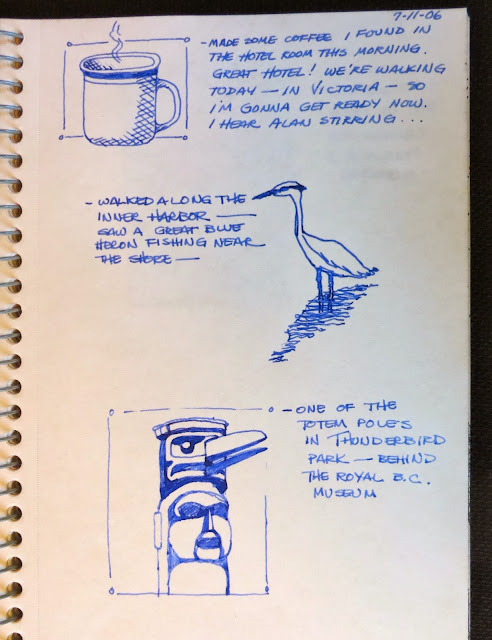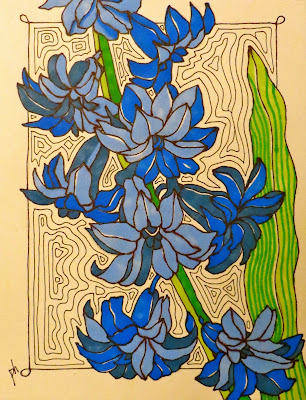To draw the mandalas, we will use some old-fashioned drawing tools -- a compass, a protractor, and a ruler/straight-edge . . .
On dry watercolor paper, draw a big circle with your compass. It's good to draw the circle with a compass rather than tracing around a dinner plate, because you will need the center dot (hole) to use as reference for your other circles and radial lines.
Now, draw a few concentric circles within the big one, with various diameters. Then, using your straight edge, draw a straight line through the center hole -- essentially cutting your circle in half. (This does not have to be parallel to the edge of your paper, but it can be.)
Take your protractor and position it over the straight line -- the little circle on the protractor lines up with the center hole, and the line lines up with the 0 degree marks. Make a small mark with your pencil at 60 degrees and 120 degrees. Then, line up the protractor on the other side of the line, and make your marks at 60 degrees and 120 degrees, on the other half of the circle . . .
Using your straight-edge, connect the dots to draw your radial lines. Make sure your straight-edge lines up with the center hole and two of the dots, so that you are drawing lines across the diameter of the circle.
Now, we will draw a few big shapes before we start painting. From now on, draw your shapes freehand, using your construction lines and circles as reference points. Start towards the middle, draw a shape and repeat it all around the circle. Then, go to the next level, draw another shape and repeat it all around the circle . . . and continue until you're at the outside of your circle. . .
Now, it's time to paint. First prepare a Yellow wash, and paint some of your shapes with it. You'll be painting "wet on dry". You won't be using any more Yellow after this stage, so make sure your wash is nice and bright. Next, prepare a light Cobalt Blue wash, and paint the outer circle and "box", painting around the slivers of yellow . . .
After this is dry, prep a wash of Quinacridone Rose. Paint over the white shapes, as well as the Yellow teardrop shapes, which will turn them Orange . . .
While the Rose wash is drying, draw another scalloped circle, within the outer circle (on the Blue). After the Rose wash is dry, draw a shape within the Orange teardrop shapes. Lastly, draw two more circles -- one within the "sunflower" shape, and another one inside the circle that touches the tips of the "sunflower petals" . . .
Now, mix up and paint the following colors, separately:
1) Quinacridone Gold -- the shapes within the "sunflower" shape.
2) Permanent Red + Quinacridone Gold -- the inner teardrop shape plus the inner background shapes.
3) Phthalo Blue + Cobalt Blue -- the outer scalloped circle (leaving the outermost circle untouched). Also, paint over the yellow slivers, at the same time, changing them to green.
Using the Blue wash, paint the corners of the "box" . . .
Now, we'll add some more shapes and darks.
Draw some more curved shapes, next to the Green slivers, and then paint them with Phthalo Blue. Paint a few of the shapes inside the inner circle, with this Blue, too.
With Permanent or Quinacridone Magenta, paint a few smaller shapes within some of the Orange shapes . . .
Draw some curved lines in pencil on the outermost rose circle. (I know it looks orange in this picture, but it should be rose.)
With the Permanent or Quinacridone Magenta, paint the smaller shapes that the curved lines created. Now, mix up a dark purple (Magenta & French Ultramarine), and paint a few dark shapes around and within your mandala . . .
I hope this is the first of many mandalas you draw and paint. They seem to be like snowflakes -- no two are the same.































